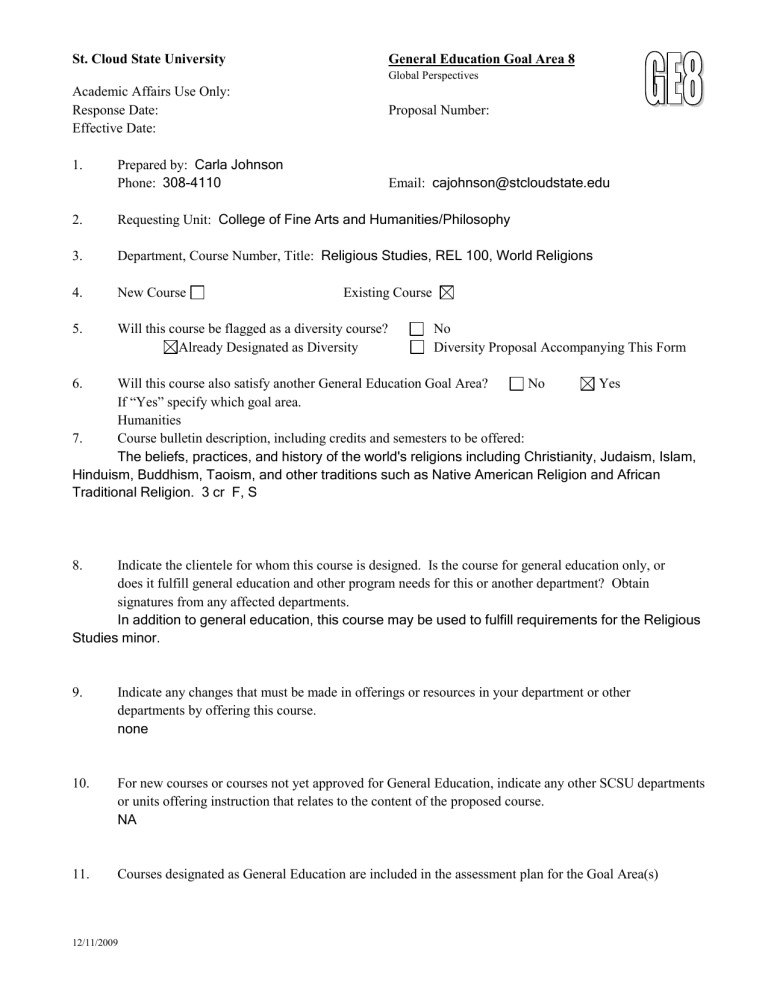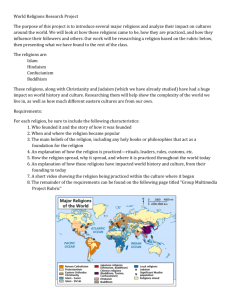GE-10-351 REL 100 World Religions

St. Cloud State University
Academic Affairs Use Only:
Response Date:
Effective Date:
1. Prepared by:
Carla Johnson
Phone:
308-4110
2.
General Education Goal Area 8
Global Perspectives
Proposal Number:
Email: cajohnson@stcloudstate.edu
Requesting Unit:
College of Fine Arts and Humanities/Philosophy
3. Department, Course Number, Title:
Religious Studies, REL 100, World Religions
4.
5.
New Course Existing Course
6.
Will this course be flagged as a diversity course? No
Already Designated as Diversity Diversity Proposal Accompanying This Form
Will this course also satisfy another General Education Goal Area?
If “Yes” specify which goal area.
No Yes
Humanities
7. Course bulletin description, including credits and semesters to be offered:
The beliefs, practices, and history of the world's religions including Christianity, Judaism, Islam,
Hinduism, Buddhism, Taoism, and other traditions such as Native American Religion and African
Traditional Religion. 3 cr F, S
9.
8. Indicate the clientele for whom this course is designed. Is the course for general education only, or does it fulfill general education and other program needs for this or another department? Obtain signatures from any affected departments.
In addition to general education, this course may be used to fulfill requirements for the Religious
Studies minor.
Indicate any changes that must be made in offerings or resources in your department or other departments by offering this course. none
10. For new courses or courses not yet approved for General Education, indicate any other SCSU departments or units offering instruction that relates to the content of the proposed course.
NA
11. Courses designated as General Education are included in the assessment plan for the Goal Area(s)
12/11/2009
for which they are approved. Courses for which assessment is not included in the annual GE assessment report for two years will be removed from the General Education Program.
The Requesting Unit understands and recognizes the above conditions.
12. Provide a concise explanation of how the following goal is a “significant focus” of the proposed course.
Goal Area 8: Global Perspectives
Develop a comparative perspective and understanding of one’s place in a global context.
This course gives students the opportunity to study a broad range of the world's living religions in order to understand the religious beliefs and practices of the peoples of the world, recognize the distinctives of each tradition as well as the commonalities between them, understand them in their historical context and interrelationships, and appreciate the contributions of each to our current global situation.
13. In order for a course to be designated as fulfilling Goal Area 8, it must address at least 4 of the 5 student learning outcomes (SLOs) below. Check the SLOs below that are focused on in the proposed general education course.
1. Explain how they are connected and related to people elsewhere in the world.
2. Describe similarities and differences among global places and populations.
3. Analyze how political, economic or cultural elements influence relations among the world’s states, peoples, or societies.
4. Analyze specific international issues and propose and evaluate responses.
5. Articulate a vision of their individual roles and responsibilities in a common global future.
14. Discuss how each Student Learning Outcome checked above is achieved in this course. (Note: Although descriptions of typical assignments or types of assignments may be part of this discussion, it is not appropriate to submit copies of actual assignments.)
1. Through readings, video presentations and discussions related to the historical development and contemporary practice of diverse religious traditions, students will come to understand the extensive and complex relationships between the world's living religions as well as between the cultures and persons who identify with those religious traditions.
2. In discussion and written assignments, students will analyze elements of the beliefs and practices of the worlds religions, identifying common themes and ideas as well as distinctive elements as shown in ritual, sacred story and belief systems of the world's religions.
3. Through readings, lectures and discussion and as evidenced in written assessments (exams or essays), students will be able to identify the social, cultural and material contexts within which the world's religions originated and developed, as well as the ways in which these circumstances have contributed to or created obstacles to that development.
5. In written assignments or presentations, students will articulate, explain/support and critically evaluate their personal perspectives on issues related to contemporary religious belief and practice.
15. List or attach the Course Outline (adequately described and including percentage of time to be allocated
12/11/2009
to each topic). Curriculum Committees may request additional information. Topics larger than 20% need to be broken down further. Indicate in your course outline where the Student Learning Outcomes checked above are being met.
Introduction to the study of religions 5% (SLO 3)
Elements of religion 10% (SLO 3)
Traditional and indigenous religions 10% (SLO 1, 2, 3)
Religions of the East 30% (SLO 1, 2, 3)
Hinduism 10
Buddhism 10
Confucianism and Daoism 10
Western Monotheistic religions 30% (SLO 1, 2, 3)
Judaism 10
Christianity 10
Islam 10
Other traditions/emerging religions and contemporary issues 15% (SLO 1, 5)
12/11/2009
St. Cloud State University General Education Transmittal Form
Academic Affairs Use Only:
Response Date:
Effective Date:
Proposal Number
Department:
College of Fine Arts and Humanities/Philosophy
Course or Course(s):
REL 100
Carla Johnson, Philosophy, and Mark Springer, Int. Dir. Religious Studies-Int. Assoc. Dean-COFAH
3/1/10
Department or Unit Chair Signature Date
Department forward to Academic Affairs for publication and electronically to Chair of General Education Committee, Chair of College Curriculum Committee, College Dean
Recommendation of General Education Committee:
Chairperson
Approve Disapprove
Remarks:
Committee
Signature
Recommendation of University Curriculum Committee:
Chairperson
Approve Disapprove
Committee
Signature
Date
Date
Recommendation of Faculty Association:
Approve Disapprove
FA Senate
Signature
Action of Academic Vice President:
Approve Disapprove
Signature
Entered in Curriculum Data File
Date
Date
Remarks:
Remarks:
Remarks:
12/11/2009









